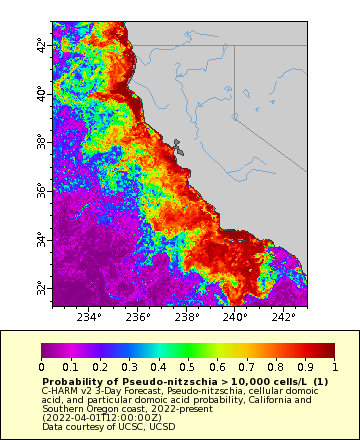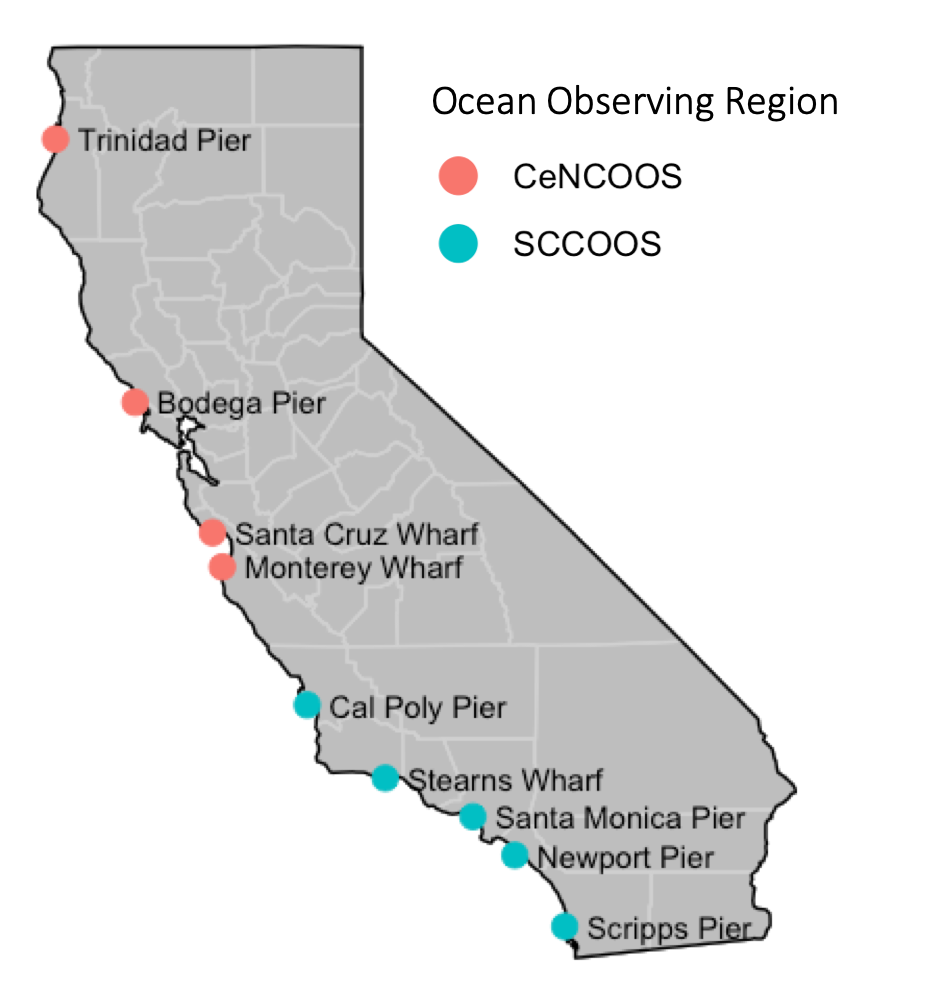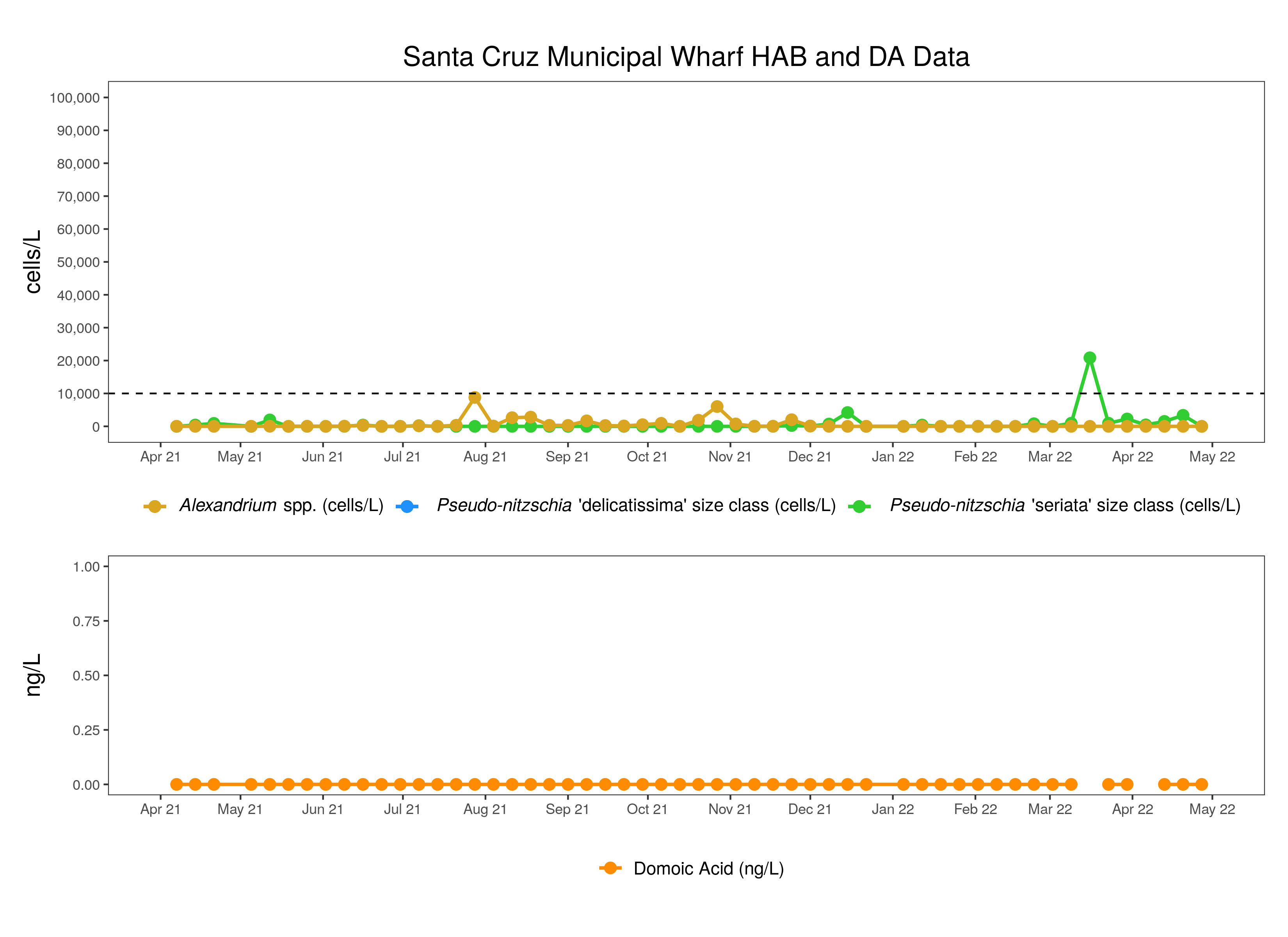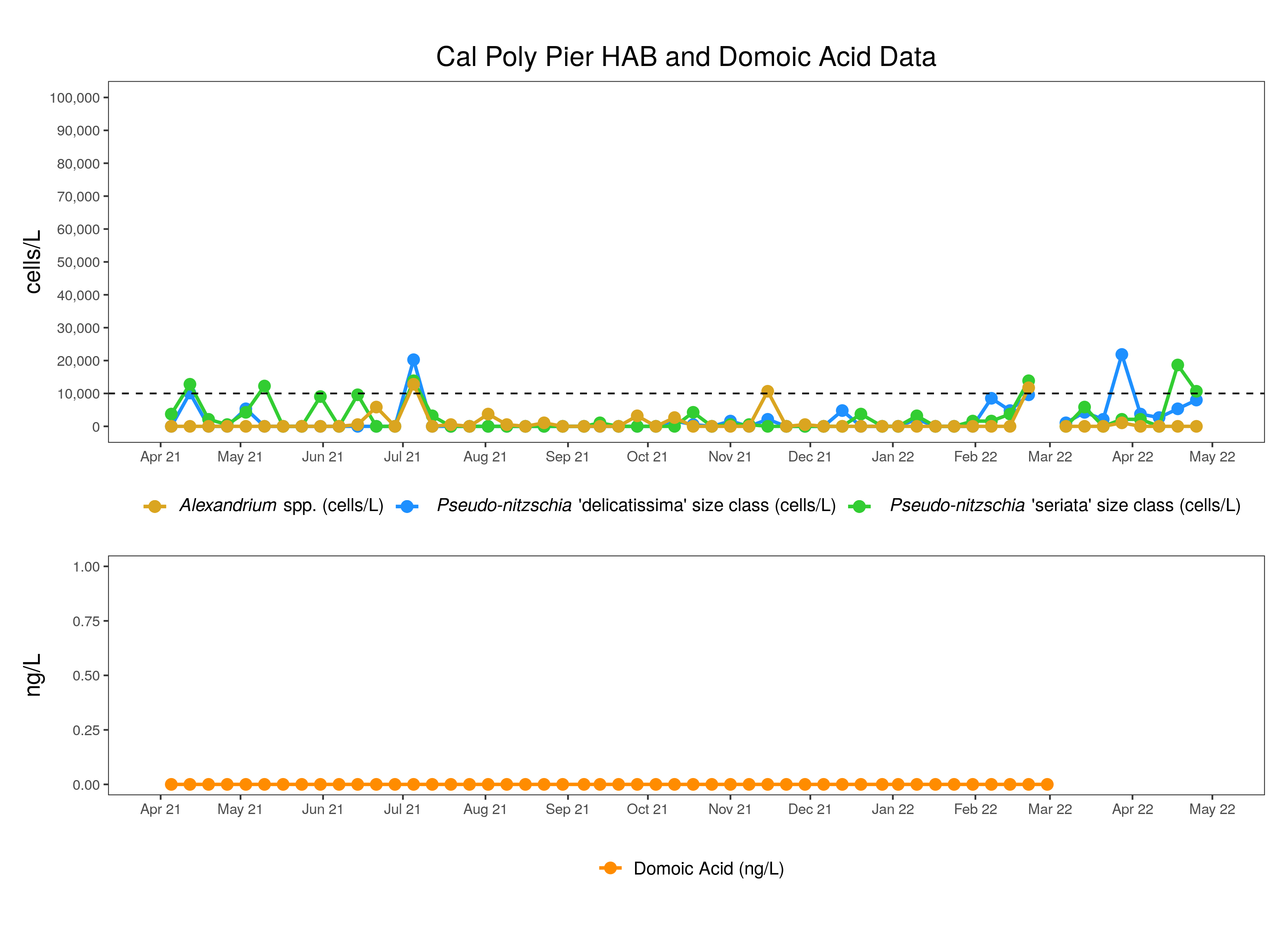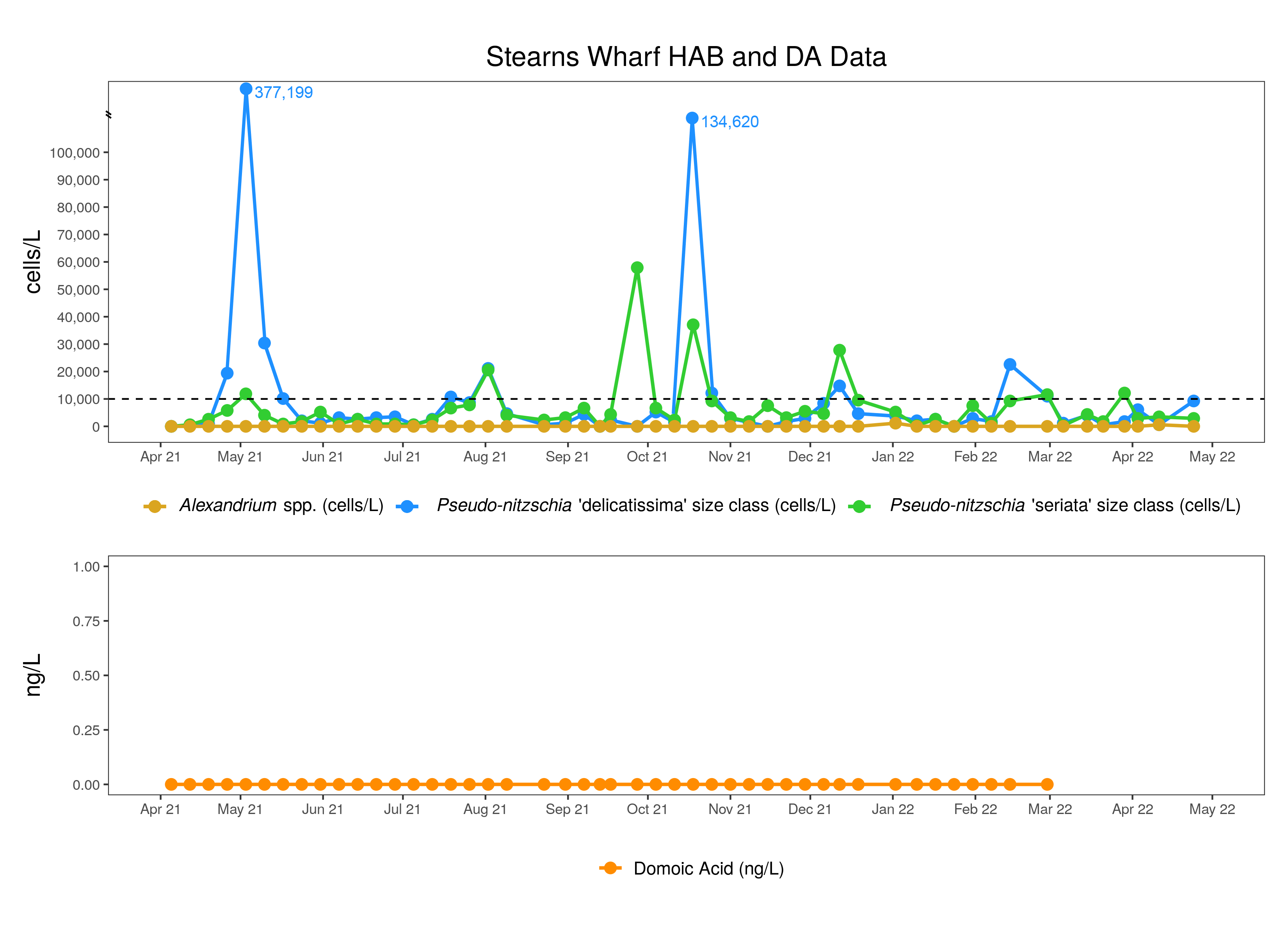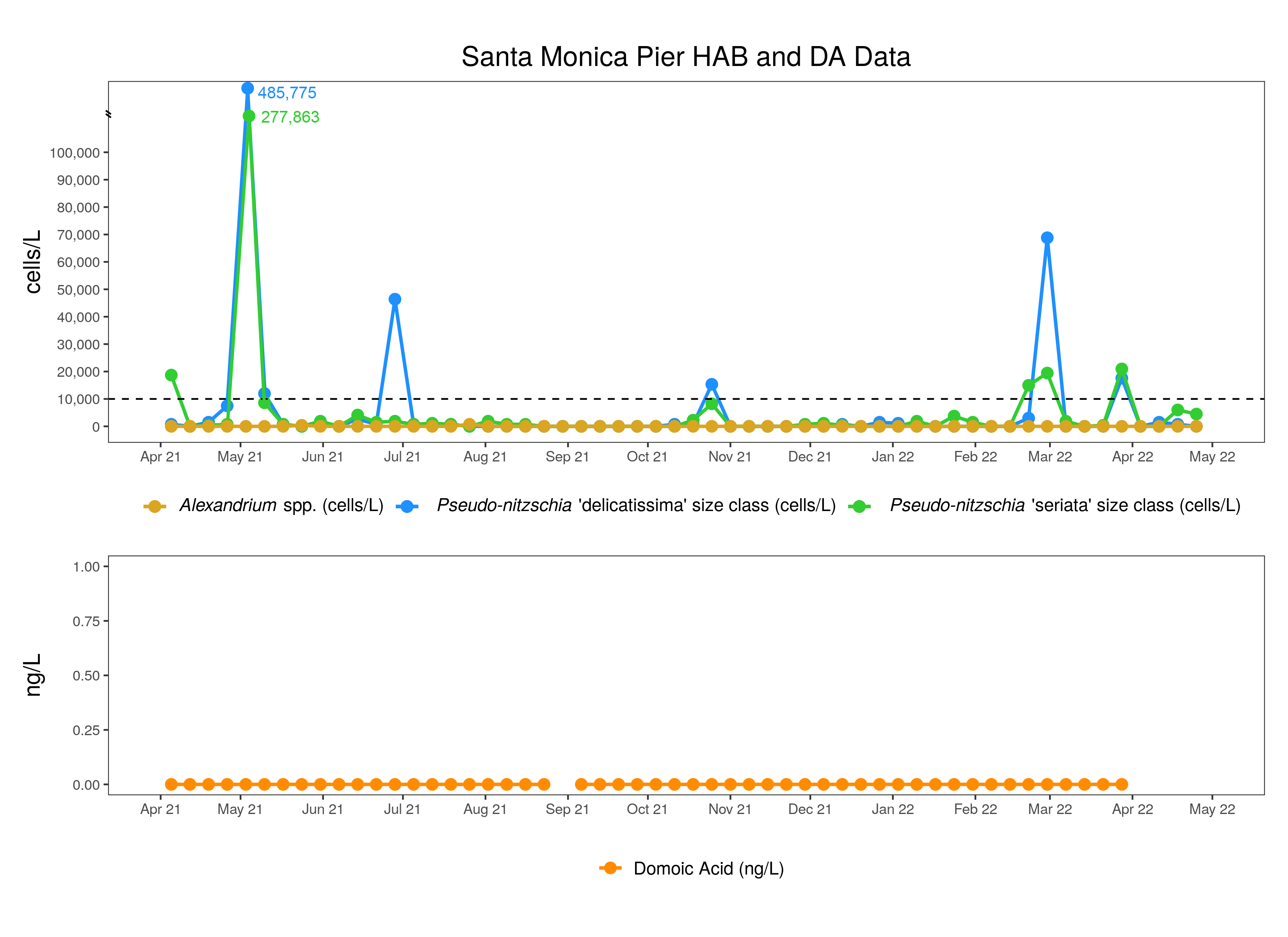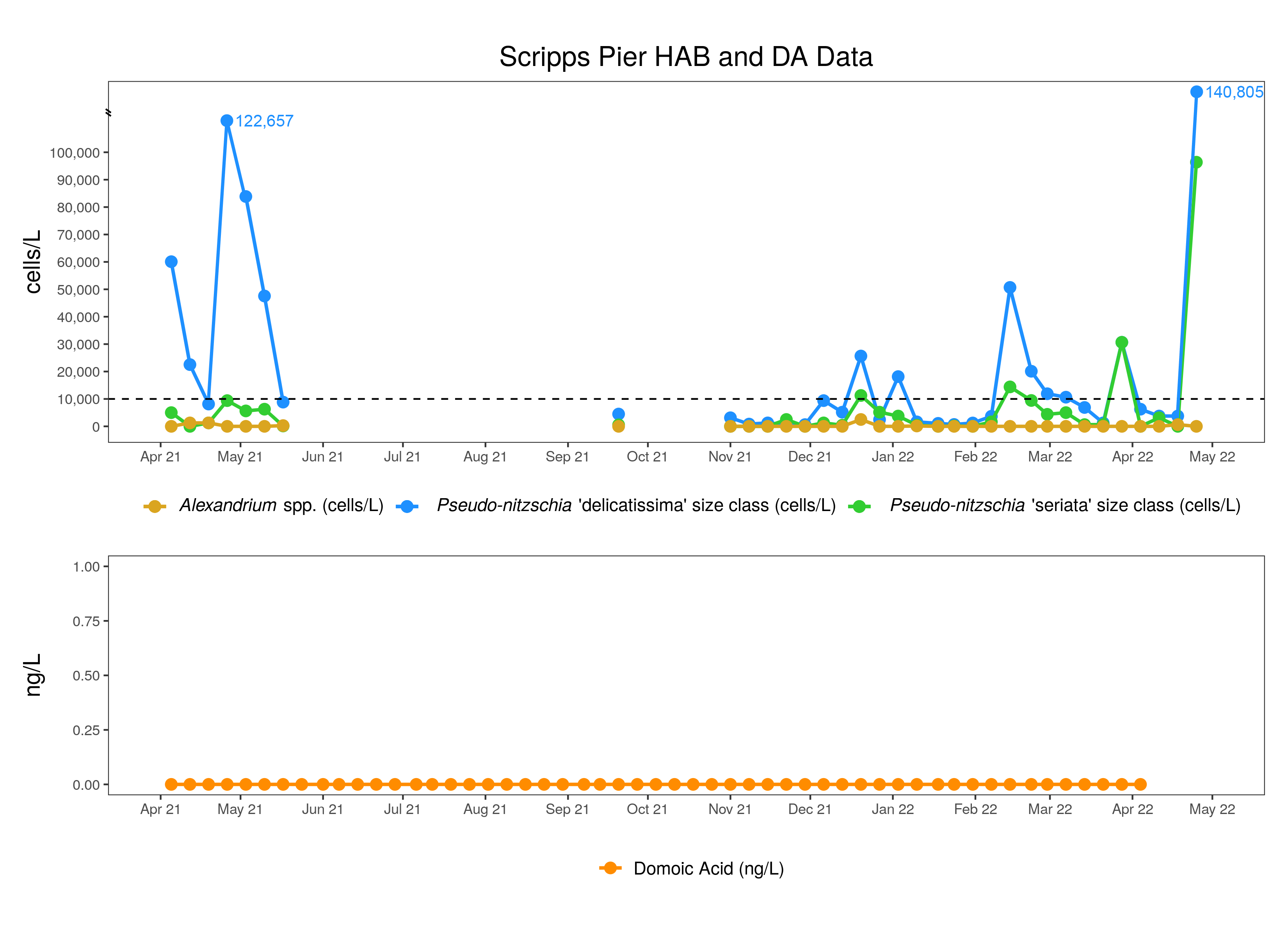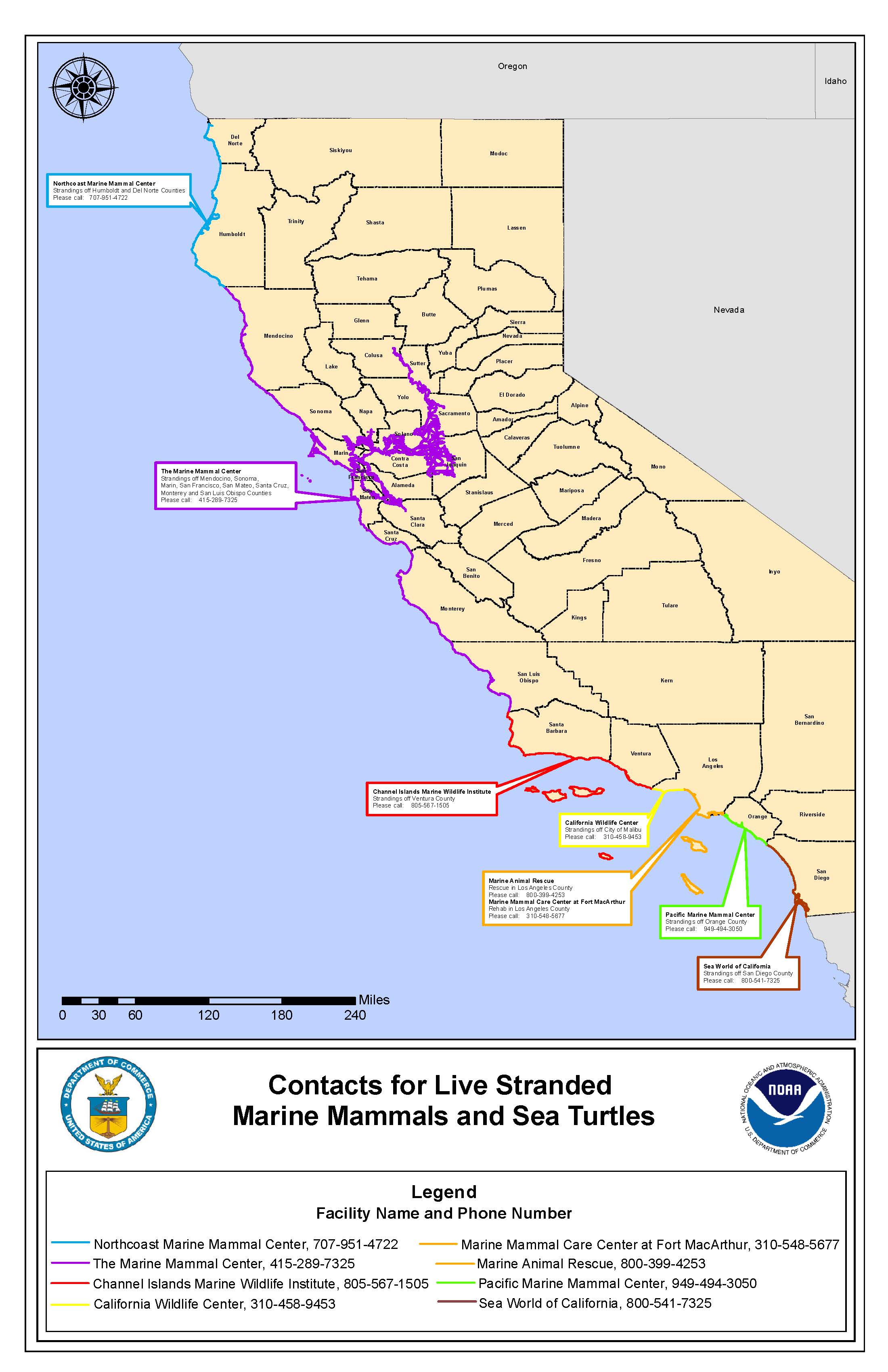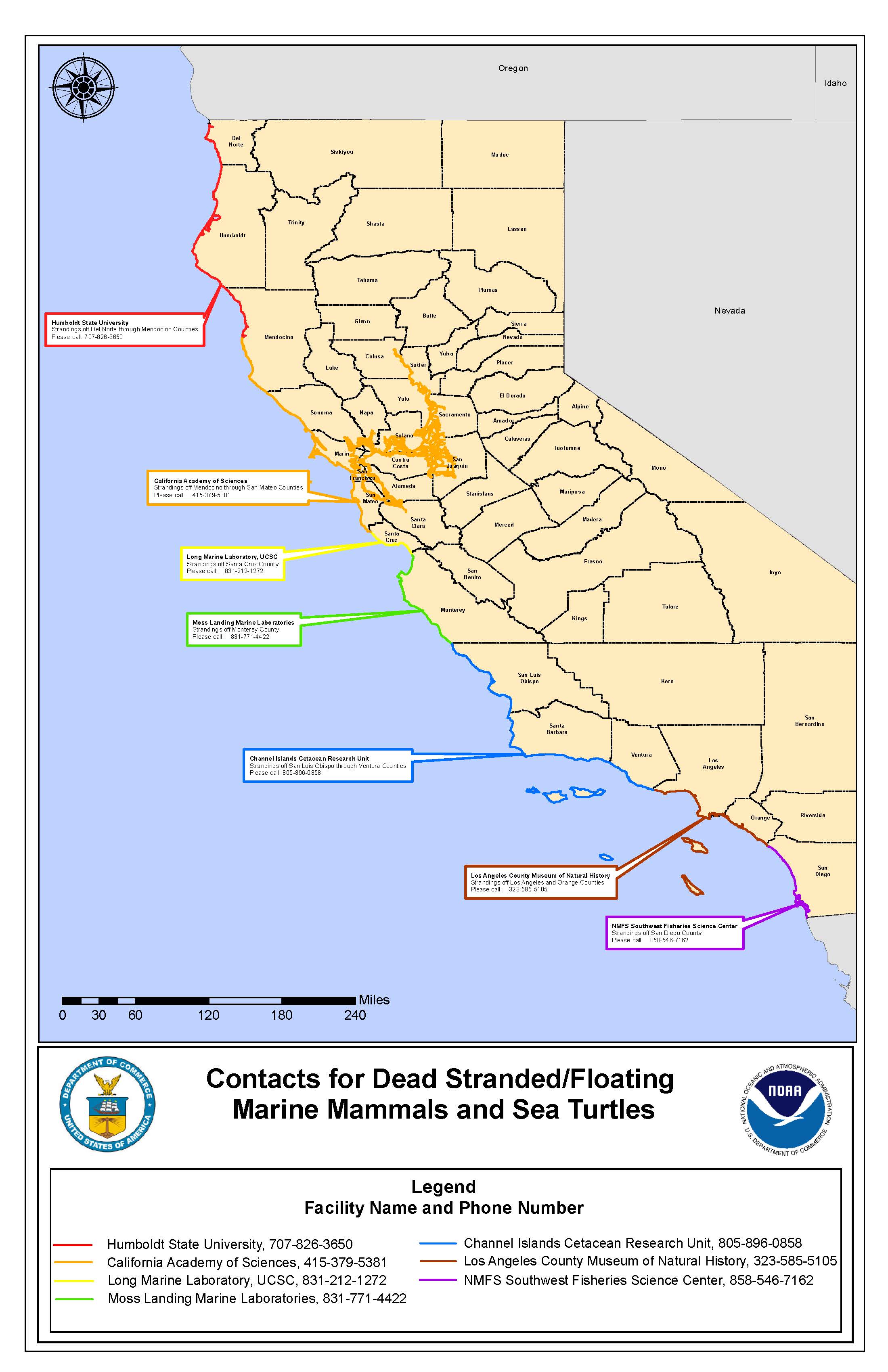APRIL HIGHLIGHTS
Pseudo-nitzschia -
- C-HARM tells us where conditions are suitable for species of the diatom Pseudo-nitzschia spp. (all size classes) to grow well and where they might be more likely to produce the deadly neurotoxin, domoic acid (DA).
- C-HARM predictions for Pseudo-nitzschia spp. blooms in April suggested even greater bloom potential than in March, with extensive spread offshore for most of the State. High bloom probabilities were patchy in the Southern California Bight southeast of the Santa Barbara Channel until later in the month, when bloom predictions intensified. As in March, this is the expected climatology for April when the upwelling season is in full force, fueling blooms in high nutrient concentrations from depth and high light from solar irradiance.
- Unlike in March, Pseudo-nitzschia spp. was only blooming at central and southern California HABMAP pier sites in April. The toxigenic 'seriata' group bloomed at Cal Poly Pier, Newport Beach Pier, and (especially) Scripps Pier at various points in April, particularly in the latter half of the month, which is consistent with the C-HARM predictions for late April. This is a good indicator of the onset of the spring bloom period as all diatoms, not just Pseudo-nitzschia species, are poised for an increase in dominance as spring conditions become more prevalent.
- Pseudo-nitzschia activity from CDPH sampling pointed to possible bloom activity for the 'seriata' group at southern sites, such as Catalina Island, Santa Monica Pier, and Palos Verdes. Interestingly, the 'seriata' group was 'Abundant' at a Santa Cruz site despite the Santa Cruz Wharf HABMAP site only noting the presence of the Pseudo-nitzschia 'seriata' group (at low abundance).
- The CA Imaging FlowCytobot Network snapshot from April shows a large Akashiwo sanguinea "red tide" bloom (considered harmful for birds, primarily) at Newport Beach Pier. This dinoflagellate bloomed periodically at southern California sites in April, eventually dissipating as diatoms like Pseudo-nitzschia became more prevalent.
- C-HARM probabilities for particulate domoic acid (pDA) in April suggested high DA activity in the Santa Barbara Channel region, which had been growing into a potentially large hot spot in late March. This persisted through April, with much of the central and north coast predicted to be high DA, although with a very nearshore band of high probabilities north of Sonoma County. In late April, a bolus of high-probability pDA developed around Orange County and San Diego.
- The pattern for C-HARM predictions of cellular domoic acid (cDA) probability was similar to pDA for April, although the southern California pattern diverged a bit with very low probabilities for high cDA during much of the month but developing in sync with pDA predictions by the end of April.
- Interestingly, for much of the month where domoic acid data are available from HABMAP sampling sites, no DA was detected.
- Only one DA toxicosis case was reported in April -- by Sea World. This animal was retrieved on 17 April and is consistent with rising pDA probabilities near San Diego mid to late April as well as with the rise in the 'seriata' size class at Newport Beach Pier and Scripps Pier in mid to late April.
- CDPH health advisories have been stable with no new advisories since December, although the recreational razor clam advisory still stands for Del Norte County.
Alexandrium -
- CDPH had only one "Present" measure for Alexandrium spp. in April, at Goleta Pier in Santa Barbara. This is consistent with HABMAP sampling which found no Alexandrium spp. at pier sites in March. There are currently no advisories for Paralytic Shellfish Poisoning.
*Please note that HABMAP sampling, CDPH sampling, and marine mammal rescues have been greatly reduced in response to COVID-19 safety measures.
Summary written by Clarissa Anderson on June 15, 2022
Note that data for some stations are not shown because they are not yet recorded in the public HABMAP archive.
Differentiating Pseudo-nitzschia species by light microscopy is difficult. For this reason, Pseudo-nitzschia "seriata" does not refer to an actual species but rather the larger size class of Pseudo-nitzschia, which is generally a more toxigenic group of species. Alternatively, Pseudo-nitzschia "delicatissima" refers to the smaller size class that is generally non-toxigenic. The dashed line on the plots demarcates the 10,000 cells/L "bloom" threshold designated here for Pseudo-nitzschia populations only.
More information and data visualizations on the statewide HAB network and forecasting system can be found on the California HABMAP website and on the SCCOOS Harmful Algal Bloom page.
Four water samples were collected at Santa Cruz Wharf in April. Molecular probes for toxigenic Pseudo-nitzschia in the "seriata" class are conducted for this site, and was detected on the first three occasions (April 6, 13, 20), all below the bloom threshold. Alexandrium spp. were not detected. Domoic acid was not detected, but one sample is pending.
The Santa Cruz Wharf shore station is supported by CeNCOOS PI Raphael Kudela at UCSC.
Four water samples were collected at Cal Poly Pier in April. Pseudo-nitzschia "delicatissima" was detected on each occasion (April 4, 11, 18, 25), all below the bloom threshold. Pseudo-nitzschia "seriata" were detected on three occasions (April 4, 18, 25), with the last two samples above the bloom threshold. Alexandrium spp. were not detected. Domoic acid results are pending.
Cal Poly Pier shore station is supported by SCCOOS and PIs Ryan Walter and Ally Pasulka at Cal Poly.
Three water samples were collected at Stearns Wharf in April. Pseudo-nitzschia "delicatissima" and Pseudo-nitzschia "seriata" were detected on each occasion (April 3, 11, 24), all below the bloom threshold. Alexandrium spp. were detected once on April 11. Domoic acid results are pending.
Stearns Wharf is supported by SCCOOS and PIs Mark Brzezinski and Libe Washburn at UCSB.
Four water samples were collected at Santa Monica Pier in April. Pseudo-nitzschia "delicatissima" was detected twice (April 11, 18) below the bloom threshold. Pseudo-nitzschia "seriata" was also detected twice (April 18, 25), below the bloom threshold. Alexandrium spp. were not detected and domoic acid results are pending.
The Santa Monica Pier shore station is supported by SCCOOS and PI Rebecca Shipe at UCLA.
Four water samples were collected at Newport Beach Pier in April. Pseudo-nitzschia "delicatissima" was detected once (April 25) below the bloom threshold. Pseudo-nitzschia "seriata" was detected twice (April 4, 25), with the last sample above the bloom threshold. Alexandrium spp. were detected once on April 4 and domoic acid results are pending.
Newport Beach Pier is supported by SCCOOS and PI David Caron at USC.
Four water samples were collected at Scripps Pier in April. Pseudo-nitzschia "delicatissima" was detected on each occasion (April 4, 11, 18, 25), with the last sample above the bloom threshold. Pseudo-nitzschia "seriata" was detected twice (April 11, 25), with the last sample above the bloom threshold. Alexandrium spp. were detected once on April 18. Domoic acid was not detected on April 4 and additional results are pending.
Scripps Pier is supported by SCCOOS and PIs Melissa Carter and Clarissa Anderson at UCSD.
CDPH observations for Pseudo-nitzschia "seriata" and Alexandrium spp.
View the interactive map and data table of California Department of Public Health (CDPH) data from January 2019 to present, developed by SCCOOS, below. Or, view CDPH Toxic Phytoplankton Observations Map with layers of Pseudo-nitzschia and Alexandrium spp. as well as other phytoplankton species observations (in the pop-up windows).
Data are provided by the Environmental Management Branch of the CDPH. Please note, starting in July 2019, CDPH moved to only reporting Pseudo-nitzschia of the seriata complex and not all Pseudo-nitzschia spp. as previously provided.
Please email CDPH at Susan.Paulukonis@cdph.ca.gov for any potential marine HAB-related illness in humans.
From April 1-30 2022, water samples were collected by volunteers and sent to the California Department of Public Health (CDPH) for analysis.
Pseudo-nitzchia "seriata" group was detected in 54 of the 77 samples:
Pseudo-nitzschia "seriata" was detected at "Abundant" density levels on 1 occasion:
- 2022-04-07 50% Santa Cruz, Seacliff Pier
Pseudo-nitzschia "seriata" was detected at "Common" density levels on 4 occasions:
- 2022-04-20 45% Santa Cruz Wharf
- 2022-04-21 12% Santa Monica Pier
- 2022-04-23 20% Catalina Island, OFFSHORE
- 2022-04-30 10% Palos Verdes, OFFSHORE
Pseudo-nitzschia "seriata" was detected at "Present" density levels on 33 occasions:
- 2022-04-03 1% Pacifica Pier
- 2022-04-04 1% Tomales Bay, Lease #M430-15
- 2022-04-04 2.5% La Jolla, Scripps Pier
- 2022-04-04 3% Ventura, Port Hueneme Pier
- 2022-04-05 3% Crystal Cove SB, OFFSHORE
- 2022-04-06 5% Palos Verdes, OFFSHORE
- 2022-04-06 6% Santa Cruz Wharf
- 2022-04-08 4% Bolsa Chica
- 2022-04-09 1% Pillar Point Harbor
- 2022-04-11 1% La Jolla, Scripps Pier
- 2022-04-11 2% Ventura, Port Hueneme Pier
- 2022-04-11 5% Pacifica Pier
- 2022-04-13 9% Santa Cruz, Capitola Pier
- 2022-04-14 7% Monterey Bay, Commercial Wharf
- 2022-04-15 1% Drakes Bay, Chimney Rock LBS
- 2022-04-15 1% Santa Barbara, Mohawk Reef
- 2022-04-15 4% Santa Barbara Ch., Naples Pt
- 2022-04-16 2% Pacifica Pier
- 2022-04-18 1% Tomales Bay, Lease #M430-15
- 2022-04-18 1% La Jolla, Scripps Pier
- 2022-04-20 1% Pillar Point Harbor
- 2022-04-20 1% Ventura, Port Hueneme Pier
- 2022-04-20 1% Imperial Beach Pier
- 2022-04-20 6% Bean Hollow State Beach
- 2022-04-21 5% Goleta Pier
- 2022-04-22 1% Bolsa Chica
- 2022-04-24 2% Pacifica Pier
- 2022-04-25 1% Tomales Bay, Lease #M430-15
- 2022-04-25 1% Pillar Point Harbor
- 2022-04-25 3% Agua Hedionda Lagoon
- 2022-04-25 4% La Jolla, Scripps Pier
- 2022-04-28 4% Ventura, Port Hueneme Pier
- 2022-04-29 2% Bolsa Chica
Pseudo-nitzschia "seriata" was detected at "Rare" density levels on 16 occasions:
- 2022-04-01 0.5% Bolsa Chica
- 2022-04-01 0.5% Pacific Beach Pier
- 2022-04-06 0.5% Bean Hollow State Beach
- 2022-04-10 0.5% Pismo Beach
- 2022-04-11 0.5% Humboldt Bay, Indian Is. Ch.
- 2022-04-13 0.5% Goleta Pier
- 2022-04-14 0.5% Pacific Beach Pier
- 2022-04-15 0.5% Port San Luis, Diablo Cove
- 2022-04-15 0.5% San Simeon Pier
- 2022-04-16 0.5% Palos Verdes Rocky Pt Offshore
- 2022-04-17 0.5% Ano Nuevo Beach
- 2022-04-18 0.5% Mendocino, Noyo Harbor
- 2022-04-20 0.5% Monterey, Stillwater Cove
- 2022-04-25 0.5% Morro Bay, Boat Launch
- 2022-04-26 0.5% Drakes Bay, Chimney Rock LBS
- 2022-04-28 0.5% Santa Cruz, Seacliff Pier
Alexandrium spp. were detected in 6 of the 77 samples:
Alexandrium spp. were not detected at "Common" density levels.
Alexandrium spp. were not detected at "Present" density levels.
Alexandrium spp. were detected at "Rare" density levels on 6 occasions:
- 2022-04-01 0.5% Bolsa Chica
- 2022-04-04 0.5% La Jolla, Scripps Pier
- 2022-04-13 0.5% Goleta Pier
- 2022-04-15 0.5% Santa Barbara Ch., Naples Pt
- 2022-04-25 0.1% Tomales Bay, Lease #M430-15
- 2022-04-25 0.5% La Jolla, Scripps Pier
CDPH and OEHHA Health Advisories
April 26. The California Department of Public Health (CDPH) today announced the annual quarantine of sport-harvested mussels gathered along the California coast beginning May 1.
April 2. The California Department of Public Health (CDPH) warned consumers today not to eat raw oysters from British Columbia, Canada because they may be linked to an outbreak of norovirus illnesses in California. Canadian officials continue to investigate the source of norovirus illnesses and have closed multiple growing regions in British Columbia for sanitary contamination.
December 16. The California Department of Public Health (CDPH) is advising consumers not to eat sport-harvested razor clams from Del Norte County due to dangerous levels of naturally occurring domoic acid, also referred to as Amnesic Shellfish Poisoning, being detected.
November 29. The California Department of Public Health (CDPH) has lifted the shellfish safety notification for Dungeness crab caught in state waters from the Sonoma/Mendocino County Line (38° 46.125' N. Latitude) to Point Reyes (38° N. Latitude) in Marin County.
November 5. Due to the detection of elevated levels of domoic acid, a naturally occurring toxin, the California Department of Public Health (CDPH) is warning consumers not to eat the viscera (internal organs) of Dungeness crab caught in coastal waters.
For the latest closures and updates, please visit the CDPH Health Advisories page as a central location of information related to CDPH health advisories. Also available is a map showing the current CDPH Recreational Bivalve Shellfish Advisories (see below).
The HAB-related illness workgroup has developed a new webpage for marine HAB-related illness tracking work (https://oehha.ca.gov/fish/general-info/marine-harmful-algal-bloom-hab-related-illness-tracking).
A network of Imaging FlowCytobots (IFCBs) continuously photographs particles, such as plankton, in the water. Using machine learning, plankton species can be automatically identified. This will help improve the ability to detect and respond to Harmful Algal Blooms, including the ability to assess conditions that may lead to toxin production or blooms of toxin-producing algae.
Additional images and data are available on the IFCB dashboard.
A large dinoflagellate bloom was detected at Newport Beach Pier in April. The mosaic was taken on April 25 and shows the bloom consisting of Akashiwo sanguinea. More information can be found at: https://sccoos.org/california-hab-bulletin/southern-california-spring-2022-red-tide-event/
Domoic acid (DA) is a potent neurotoxin produced by some diatom species of the genus Pseudo-nitzschia. Species exposed to DA can result in seizures, epilepsy, cardiomyopathy, and death depending upon the ingested dose. DA toxicosis commonly occurs in California Sea Lions (Zalophus californianus), presumably due to a combination of foraging behavior and seasonal movements. The Marine Mammal Center (TMMC), Channel Islands Marine Wildlife Institute (CIMWI), California Wildlife Center (CWC), Marine Mammal Care Center Los Angeles (MMCC-LA), Marine Animal Rescue (MAR), the Pacific Marine Mammal Center (PMMC), and SeaWorld act like an emergency room by working to rescue and rehabilitate sick and injured marine mammals, seabirds, and sea turtles.
TMMC, PMMC, and CWC did not record any strandings due to suspected domoic acid in April 2022. Results from MMCC-LA, MAR, and CIMWI are pending.
April strandings due to suspected DA toxicosis occurred in the following counties:
- San Diego (SeaWorld)
- April 17 - Adult, female, California Sea Lion
PMMC noted 5 deceased subadult to adult common dolphins in Newport and Huntington Beach in early May. These were in good body condition with partially digested fish in their stomachs so DA is suspected. Additionally, 3 dead sea lions, 1 dead adult harbor seal, and reports of a dead Guadalupe fur seal and elephant seal were noted.

